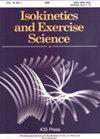阻力训练 3 周后不同速度损失训练方案对肌肉力量和功率的影响
IF 0.6
4区 医学
Q4 ENGINEERING, BIOMEDICAL
引用次数: 0
摘要
背景:有关类似总重复次数的速度损失截断训练反应的证据很有限。目的:本研究旨在考察在接受 3 周传统阻力训练后,不同的速度损失训练方案对训练男子力量和功率的影响。方法:20 名训练有素的男性参加了研究。训练方案每周进行两次,为期 6 周,前 3 周为传统(TR)训练方案,后 3 周为速度损失(VL)训练方案。TR和VL训练方案包括80% 1RM的全蹲运动,休息4分钟。在速度损失(VL)训练方案中,参与者被随机分配到两种不同的训练方案,每种方案的组内速度损失不同(V20%;n= 10 或 VL40%;n= 10)。组数经过调整,使每组 VL 的总重复次数相似(VL20 × 3 组,VL40 × 2 组)。使用单次重复最大重量(1RM)、等动力量、20 米冲刺(T20)和反身跳跃(CMJ)进行评估。结果:从TR训练方案到VL训练方案,每组的重复总次数都显著减少(TR到VL20;-18%,TR到VL40;-27%,P< 0.05)。组间重复次数无明显差异。训练 6 周后,两组的 T20 和等速力量均有显著变化。结论:事实证明,在 TR 训练方案后减少训练量的 VL 训练方案能保持并提高力量和功率效果。然而,VL20 和 VL40 方案之间的训练反应没有明显差异。结合 TR 和 VL 方案可能是优化运动表现的有效策略。本文章由计算机程序翻译,如有差异,请以英文原文为准。
The effects of different velocity loss training protocols after 3 weeks of resistance training on muscular strength and power
BACKGROUND: The evidence of response to velocity loss cut-off training with similar total repetitions are limited. OBJECTIVE: This study aimed to examine the effects of different velocity loss training protocols after 3 weeks of traditional resistance training protocols on strength and power in trained men. METHODS: Twenty highly trained men participated in the study. The protocols were performed twice a week for 6-weeks, with the first 3-weeks consisting of traditional (TR) training protocols and the other 3-weeks of velocity loss (VL) training protocols. The TR and VL training protocols consisted of 80% 1RM of full squat exercise with 4-min rest intervals. The participants were randomly assigned to two different protocols during the VL training protocols, each with different velocity loss within sets (V20%; n= 10 or VL40%; n= 10). The number of sets was adjusted so that the total number of repetitions for each VL was similar (VL20 × 3 sets, VL40 × 2 sets). Measurements assessed using one-repetition maximum (1RM), isokinetic strength, 20 m-sprint (T20), and counter movement jump (CMJ). RESULTS: The total number of repetitions in the session significantly decreased from the TR training protocol to the VL training protocol in each group (TR to VL20; -18%, TR to VL40; -27%, p< 0.05). There was no significant difference of repetitions between groups. The T20 and isokinetic strength changed significantly in both groups after 6-weeks of training. CONCLUSION: The VL training protocol with reduced volume following the TR training protocol has been shown to maintain and increase strength and power outcomes. However, no significant difference in training response was observed between VL20 and VL40 protocols. The combination of TR and VL protocols might be an effective strategy for optimizing athletic performance.
求助全文
通过发布文献求助,成功后即可免费获取论文全文。
去求助
来源期刊

Isokinetics and Exercise Science
医学-工程:生物医学
CiteScore
1.20
自引率
14.30%
发文量
37
审稿时长
>12 weeks
期刊介绍:
Isokinetics and Exercise Science (IES) is an international journal devoted to the study of theoretical and applied aspects of human muscle performance. Since isokinetic dynamometry constitutes the major tool in this area, the journal takes a particular interest in exploring the considerable potential of this technology.
IES publishes studies associated with the methodology of muscle performance especially with respect to the issues of reproducibility and validity of testing, description of normal and pathological mechanical parameters which are derivable from muscle testing, applications in basic research topics such as motor learning paradigms and electromyography. The journal also publishes studies on applications in clinical settings and technical aspects of the various measurement systems employed in human muscle performance research.
The journal welcomes submissions in the form of research papers, reviews, case studies and technical reports from professionals in the fields of sports medicine, orthopaedic and neurological rehabilitation and exercise physiology.
 求助内容:
求助内容: 应助结果提醒方式:
应助结果提醒方式:


